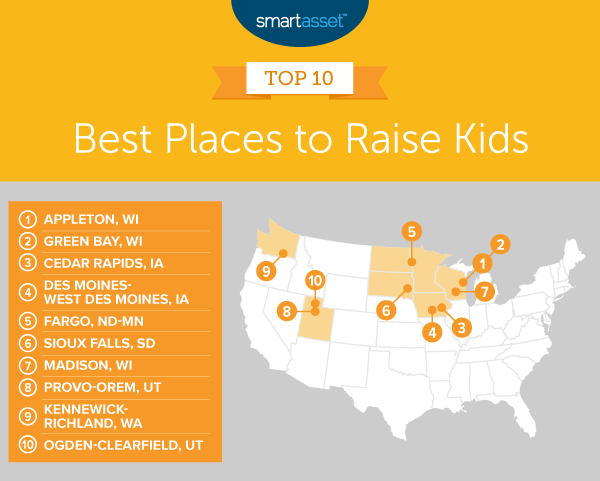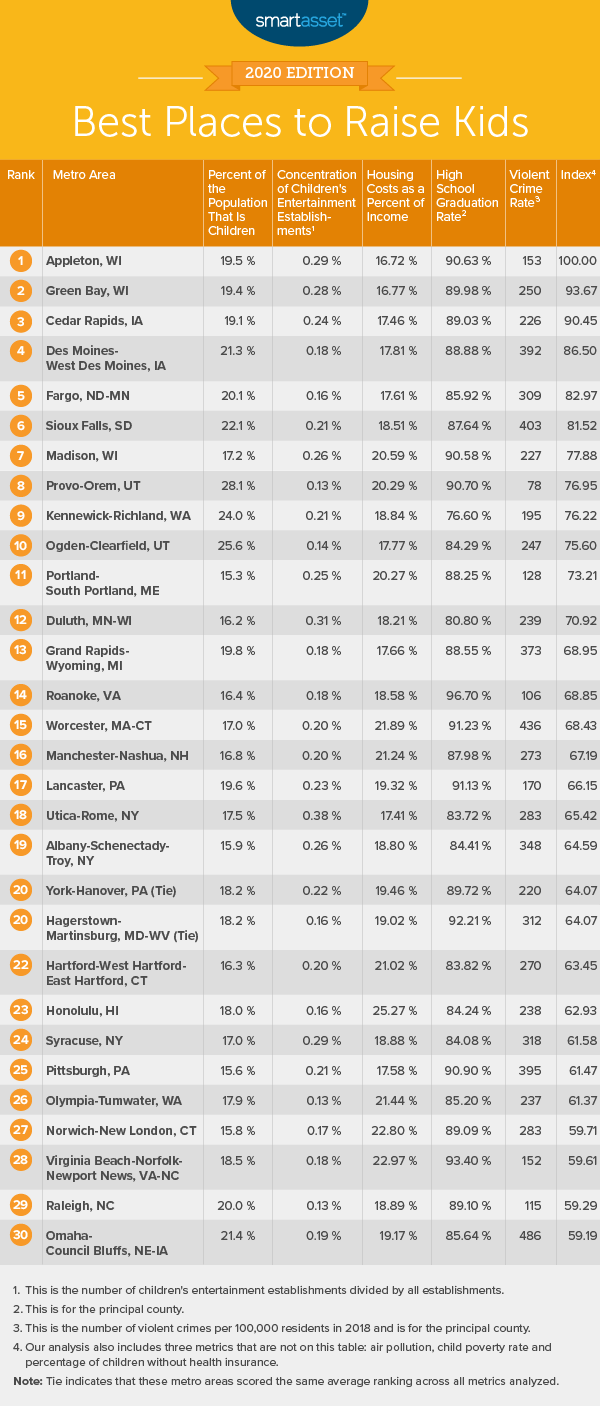
Raising kids is a difficult task – one that has been made harder for many in recent months as a result of the COVID-19 crisis and the accompanying economic trouble. Finding the best place to grow a family is a process that involves many factors that often change depending on where you look. That’s why SmartAsset analyzed the data to find the best places to raise kids in America.
We compared the 200 largest U.S. metro areas across the following metrics: percentage of the population who are children, housing costs as a percentage of income, concentration of children’s entertainment establishments, high school graduation rate, daily average air pollution, child poverty rate, percentage of the children without health insurance and violent crime rate. For details on our data sources and how we put all the information together to create our final rankings, check out the Data and Methodology section below.
Key Findings
- Midwestern locales are most favorable for raising kids. Of the top 10 places in our study, seven are in the Midwest, with particularly strong showings from Wisconsin and Iowa. The Appleton, Green Bay and Madison metro areas in Wisconsin rank first, second and seventh, respectively, and have a high concentration of children’s entertainment establishments, favorable high school graduation rates and low child poverty rates. Meanwhile, Iowa’s Cedar Rapids and Des Moines-West Des Moines areas take the No. 3 and 4 spots, respectively, ranking very well for their low housing costs as a percentage of income as well as relatively low percentages of children without health insurance.
- Insurance not necessarily ensured. With healthcare being an especially hot-button issue in America over the past several years, insurance is an especially important consideration when it comes to any family’s finances. The average percentage of children without health insurance across all 200 metro areas in the study is 4.97%, and while the majority of our top 10 metro areas fall below this rate, two areas in particular – Provo-Orem and Ogden-Clearfield, Utah – hover near or above it.
1. Appleton, WI
Appleton, Wisconsin is the best place to raise kids, according to the data we considered for our study this year. The Appleton metro area leads this list for housing costs as a percentage of income at 16.72%, so you are likely to be able to find an affordable but nice place to live with your family. It also has the sixth-lowest childhood poverty rate overall – at 7.9% – and the eighth-lowest violent crime rate overall – at 153 incidents per 100,000 residents.
2. Green Bay, WI
Packers fans, rejoice! Green Bay, Wisconsin is another very affordable option to raise kids, with housing costs representing 16.77% of income, the second-lowest rate for this metric in the study. Children’s entertainment establishments represent 0.28% of all establishments in Green Bay, the 12th-highest rate. Finally, the poverty rate among children in Green Bay is 10.6%, 22nd-lowest out of all 200 metro areas we analyzed.
3. Cedar Rapids, IA
Just 1.66% of the children in Cedar Rapids, Iowa are without health insurance, the seventh-lowest rate for this metric in the study. The metro area also has the 11th-lowest rate out of all 200 areas we considered for housing costs as a percentage of income, at 17.46%. Cedar Rapids’ violent crime rate is 226 incidents each year per 100,000 residents, ranking 17th-lowest overall.
4. Des Moines-West Des Moines, IA
The Des Moines-West Des Moines, Iowa area takes the No. 4 spot in the study. It has a population that is 21.3% children, the 25th-highest rate for this metric overall. This locale finishes in the top 25 for housing costs as a percentage of income, with the median person spending just 17.81% of their income on housing costs. It also ranks within the top 20 of the study for its low percentage of children without health insurance, at 2.15%.
5. Fargo, ND-MN
The Fargo, North Dakota-Minnesota metro area ranks within the top 10 of the study for its low average daily air pollution. The metro area also ranks within the top 15 for housing costs as a percentage of income, at 17.61%. Children make up 20.1% of the population – Fargo ranks within the top fourth of the study for this relatively high rate, meaning that children who grow up here will likely have more peers than in many other metro areas in the study.
6. Sioux Falls, SD
The Sioux Falls, South Dakota metro area’s population is 22.1% children, the 19th-highest rate for this metric in the study. The area has a child poverty rate of 8.1%, which is the eighth-best across all 200 metro areas overall. The percentage of children without health insurance – at 4.01% – ranks within the top half of the study, 98th out of 200 metro areas.
7. Madison, WI
The Madison, Wisconsin metro area ranks relatively low in terms of percentage of the population who are children, at 17.2%. Madison ranks better, though, in terms of its low child poverty rate, with just 8.5% of those children living in poverty, the 12th-best rate in the study. Madison places 18th overall in terms of violent crime, with a relatively low 227 incidents per 100,000 residents.
8. Provo-Orem, UT
Provo-Orem, Utah’s population is 28.1% children – the highest rate for this metric in the study. The metro area also comes in fourth-lowest for child poverty rate, with just 7.5% of those children living in poverty. While the Provo-Orem area doesn’t score as well in terms of health insurance, coming in the bottom quartile with 6.61% of children lacking medical insurance coverage, it does have the second-lowest violent crime rate across all 200 metro areas for which we analyzed data.
9. Kennewick-Richland, WA
Kennewick-Richland, Washington is the only metro area in our top 10 that is located in a coastal state. Kennewick-Richland’s population is 24.0% children, the 10th-highest rate for this metric in the study. The locale places 12th overall for its low violent crime rate, with 195 incidents per 100,000 residents. The metro area also ranks within the top 50 of the study for low housing costs as a percentage of income and high concentration of children’s entertainment establishments. Finally, it ranks 17th-best overall and second-best in the top 10 for its low percentage of children without health insurance, at just 2.12%.
10. Ogden-Clearfield, UT
Ogden-Clearfield, Utah is the final city in our top 10 and it has a population that is 25.6% children, the fourth-highest rate for this metric across all 200 metro areas in the study. The child poverty rate is 8.2%, the ninth-lowest rate in the study. The metro area ranks 20th overall of the study for its low housing costs as a percentage of income and 30th overall for its low violent crime rate.
Data and Methodology
To find the best cities to raise kids in 2020, we analyzed data for the 200 largest U.S. metro areas across the following metrics:
- Percentage of the population who are children. Data comes from the Census Bureau’s 2018 1-Year American Community Survey.
- Housing costs as a percentage of income. This is the median housing cost as a percentage of the median household income. Data comes from the Census Bureau’s 2018 1-Year American Community Survey.
- Concentration of children’s entertainment establishments. This is the percentage of establishments in a metro area that are related to children’s entertainment. We considered bowling alleys, zoos, sports teams, arcades, museums and theme parks as children’s entertainment establishments. Data comes from the U.S. Census Bureau’s 2018 Metro Area Business Patterns Survey.
- High school graduation rate. Data comes from the 2020 County Health Rankings (https://www.countyhealthrankings.org).
- Air pollution. This measures the average daily fine particulate matter. Data comes from the 2020 County Health Rankings.
- Child poverty rates. Data comes from the Census Bureau’s 2018 1-Year American Community Survey.
- Percentage of children without health insurance. Data comes from the Census Bureau’s 2018 1-Year American Community Survey.
- Violent crime rate. The number of incidents of violent crime per 100,000 residents. Data is from the 2020 County Health Rankings.
First, we ranked each metro area in each metric. From there, we found each metro area’s average ranking across all the metrics, assigning each metric an equal weight. We used this average ranking to create our final score. The metro area with the highest average ranking received an index score of 100. The metro area with the lowest average ranking received an index score of 0.
Tips for Managing Your Money While Raising Kids
- Grow to the next step with your finances – with a little guidance. If you want to have kids, you should get your finances in order as early as possible. A financial advisor can help you do that. Finding a financial advisor doesn’t have to be hard. SmartAsset’s free tool connects you with financial advisors in your area in five minutes. If you’re ready to be matched with local advisors, get started now.
- Need more space? Thinking of buying your dream home in one of these locales? Make sure you use our mortgage calculator to see what you might be paying each month.
- Master the ABCs of budgeting. No matter where you live or how big your family is, managing your money is important. A solid budget can be a good place to start.
Questions about our study? Contact press@smartasset.com
Photo credit: ©iStock.com/SDI Productions

